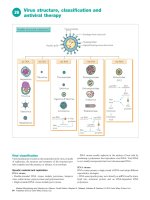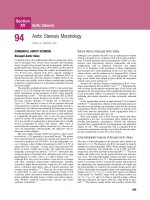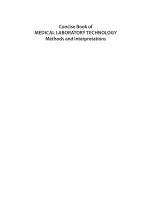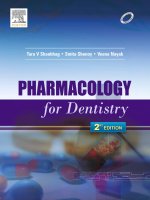Ebook NMS national medical series for independent study surgery casebook (2nd edition): Part 1
Bạn đang xem bản rút gọn của tài liệu. Xem và tải ngay bản đầy đủ của tài liệu tại đây (10.84 MB, 371 trang )
NMS
National Medical Series for Independent Study
Surgery
Casebook
Second Edition
Jarrell (Casebook)_FM.indd i
4/15/15 7:33 PM
Jarrell (Casebook)_FM.indd ii
4/15/15 7:33 PM
NMS
National Medical Series for Independent Study
Surgery
Casebook
Second Edition
Bruce E. Jarrell, MD
Professor
Department of Surgery
University of Maryland School of Medicine
Baltimore, Maryland
Eric D. Strauch, MD
Associate Professor
Department of Surgery
University of Maryland School of Medicine
Baltimore, Maryland
Jarrell (Casebook)_FM.indd iii
4/15/15 7:33 PM
Acquisitions Editor: Tari Broderick
Product Development Editor: Amy Weintraub
Editorial Assistant: Joshua Haffner
Marketing Manager: Joy Fisher-Williams
Production Project Manager: Priscilla Crater
Design Coordinator: Terry Mallon
Manufacturing Coordinator: Margie Orzech
Prepress Vendor: Absolute Service, Inc.
Second Edition
Copyright © 2016 Wolters Kluwer
Copyright © 2003 Lippincott Williams & Wilkins
All rights reserved. This book is protected by copyright. No part of this book may be reproduced or transmitted in any form or by any means, including as photocopies or scanned-in or other electronic copies, or utilized
by any information storage and retrieval system without written permission from the copyright owner, except
for brief quotations embodied in critical articles and reviews. Materials appearing in this book prepared by
individuals as part of their official duties as U.S. government employees are not covered by the above-mentioned
copyright. To request permission, please contact Wolters Kluwer at Two Commerce Square, 2001 Market
Street, Philadelphia, PA 19103, via email at , or via our website at lww.com (products and
services).
9 8 7 6 5 4 3 2 1
Printed in China
Library of Congress Cataloging-in-Publication Data
Jarrell, Bruce E., author.
NMS surgery casebook / Bruce E. Jarrell, Eric D. Strauch. — Second edition.
p. ; cm. — (National medical series for independent study)
Surgery casebook
National medical series surgery casebook
Companion to: NMS surgery / [edited by] Bruce E. Jarrell, Stephen M. Kavic. Sixth edition. [2016].
Includes bibliographical references and index.
ISBN 978-1-60831-586-4
I. Strauch, Eric D., author. II. NMS surgery. Complemented by (work): III. Title. IV. Title: Surgery casebook. V.
Title: National medical series surgery casebook. VI. Series: National medical series for independent study.
[DNLM: 1. Surgical Procedures, Operative—Case Reports. 2. General Surgery—Case Reports. WO 18.2]
RD37
617—dc23
2015010502
This work is provided “as is,” and the publisher disclaims any and all warranties, express or implied, including any
warranties as to accuracy, comprehensiveness, or currency of the content of this work.
This work is no substitute for individual patient assessment based on healthcare professionals’ examination of
each patient and consideration of, among other things, age, weight, gender, current or prior medical conditions,
medication history, laboratory data, and other factors unique to the patient. The publisher does not provide
medical advice or guidance and this work is merely a reference tool. Healthcare professionals, and not the
publisher, are solely responsible for the use of this work including all medical judgments and for any resulting
diagnosis and treatments.
Given continuous, rapid advances in medical science and health information, independent professional verification
of medical diagnoses, indications, appropriate pharmaceutical selections and dosages, and treatment options should
be made and healthcare professionals should consult a variety of sources. When prescribing medication, healthcare
professionals are advised to consult the product information sheet (the manufacturer’s package insert) accompanying each drug to verify, among other things, conditions of use, warnings, and side effects and identify any changes
in dosage schedule or contraindications, particularly if the medication to be administered is new, infrequently
used, or has a narrow therapeutic range. To the maximum extent permitted under applicable law, no responsibility
is assumed by the publisher for any injury and/or damage to persons or property, as a matter of products liability,
negligence law or otherwise, or from any reference to or use by any person of this work.
LWW.com
Jarrell (Casebook)_FM.indd iv
4/15/15 7:33 PM
This book is dedicated to several important people that have strongly
influenced my ability to pursue a medical student–oriented career.
To Brigadier General Fritz Plugge, MC, USAF (Ret), who has been
amazingly kind in his support of this department
To Lazar Greenfield, MD, who has been a wonderful role model for many
of us in surgery
To Donald Wilson, MD; James Dalen, MD; Joe Gonella, MD;
Frank Calia, MD; Albert Reece, MD; and Jay Perman, MD,
my deans, who have each given me the opportunity
to be with medical students my entire life
And to my family, Leslie, Noble, Kevin, Gwynneth, Jerry, Dad, and Mom,
who have always helped me out
Bruce E. Jarrell, MD
To Stephen Bartlett, MD; Bruce Jarrell, MD; and Roger Voigt, MB, ChB,
for being strong role models and their support
To my family, Cecilia, Jacob, Julia, Jessica, Jenna, Dad, and Mom for their
love and support
Eric D. Strauch, MD
Jarrell (Casebook)_FM.indd v
4/15/15 7:33 PM
Preface
During our combined five decades of work with medical students in their
clinical years, they have stimulated us to think about how we can do a better
job of teaching. The second edition of Surgery Casebook is one way of trying
to attain that goal. The cases in this book represent how we, as experienced
surgeons, think and make decisions about a clinical problem. We have attempted to write it in a way that allows us to talk to you as you read it, so that
the book will be the next best thing to teaching in person.
The cases are organized into body systems, and they represent common
presentations. The history and physical examination clues help you reach a
diagnosis. Illustrations have been added and enhanced with color and are
used liberally to help you detect visual clues. Clinical images are also used
in abundance. Case variations are also presented to help you consider treatment of patients with various complications and coexisting conditions. An
all-new pediatrics chapter has been added that covers common congenital
anomalies.
This book is of use to third- and fourth-year medical students in their surgery rotation as well as interns and residents planning to enter the field of
surgery. Using this book alone or in combination with NMS Surgery, sixth
edition, will help you apply your knowledge to decision making in clinical
situations and master all of the steps in managing a patient.
vi
Jarrell (Casebook)_FM.indd vi
4/15/15 7:33 PM
Contributors
Emily Bellavance, MD
Assistant Professor of Surgery
Division of Surgical Oncology
University of Maryland School of Medicine
Baltimore, Maryland
Marshall Benjamin, MD
Associate Professor of Surgery
Division of Vascular Surgery
University of Maryland School of Medicine
Director, Maryland Vascular Center
Chairman, Department of Surgical Services
UM Baltimore Washington Medical Center
Baltimore, Maryland
Daniel Bochicchio, MD, FCCP
Assistant Professor
Anesthesiology and Critical Care Medicine
Baltimore VA Medical Center
Baltimore, Maryland
Molly Buzdon, MD, FACS
Chairman
Department of Surgery
Portsmouth Regional Hospital
Portsmouth, New Hampshire
W. Bradford Carter, MD
Medical Director
Alvin & Lois Lapidus Cancer Institute at Sinai and Northwest Hospitals
Baltimore, Maryland
Clint D. Cappiello, MD
Resident in Surgery
University of Maryland School of Medicine
Baltimore, Maryland
vii
Jarrell (Casebook)_FM.indd vii
4/15/15 7:33 PM
viii
Contributors
John L. Flowers, MD, FACS
Chief of Surgery
Department of General Surgery
Greater Baltimore Medical Center
Towson, Maryland
Joseph S. MacLaughlin, MD
Professor (Retired)
Division of Cardiac Surgery
University of Maryland School of Medicine
Baltimore, Maryland
Thomas Scalea, MD
Physician-in-Chief
R Adams Cowley Shock Trauma Center
Professor of Surgery
Director, Program in Trauma
University of Maryland School of Medicine
Baltimore, Maryland
Katherine Tkaczuk, MD
Professor of Medicine
Director, Breast Evaluation and Treatment Program
Marlene and Stewart Greenebaum Cancer Center
University of Maryland School of Medicine
Baltimore, Maryland
Michelle Townsend-Watts, MD
Assistant Professor of Diagnostic Radiology
University of Maryland School of Medicine
Baltimore, Maryland
Jarrell (Casebook)_FM.indd viii
4/15/15 7:33 PM
Contents
Part I: General Issues
1
Preoperative Care . . . . . . . . . . . . . . . . . . . . . . . . . . . . 1
Bruce E. Jarrell, Molly Buzdon, Daniel Bochicchio, Eric D. Strauch
2
Postoperative Care . . . . . . . . . . . . . . . . . . . . . . . . . . 25
Bruce E. Jarrell, Molly Buzdon, Eric D. Strauch
3
Wound Healing . . . . . . . . . . . . . . . . . . . . . . . . . . . . . . 37
Bruce E. Jarrell, Eric D. Strauch
Part II: Specific Disorders
4
Thoracic and Cardiothoracic Disorders . . . . . . . . . 49
Bruce E. Jarrell, Joseph S. MacLaughlin, Eric D. Strauch
5
Vascular Disorders . . . . . . . . . . . . . . . . . . . . . . . . . . 96
Bruce E. Jarrell, Marshall Benjamin, Eric D. Strauch
6
Upper Gastrointestinal Tract Disorders . . . . . . . . . 144
Bruce E. Jarrell, John L. Flowers, Molly Buzdon, Eric D. Strauch
7
Pancreatic and Hepatic Disorders . . . . . . . . . . . . . 173
Bruce E. Jarrell, Eric D. Strauch
8
Lower Gastrointestinal Disorders . . . . . . . . . . . . . 210
Bruce E. Jarrell, Molly Buzdon, Daniel Bochicchio, Eric D. Strauch
ix
Jarrell (Casebook)_FM.indd ix
4/15/15 7:33 PM
x
Contents
9
Endocrine Disorders . . . . . . . . . . . . . . . . . . . . . . . . . . . . . . 279
Bruce E. Jarrell, W. Bradford Carter, Eric D. Strauch
10
Skin and Soft Tissue Disorders and Hernias . . . . . . . . . . 299
Bruce E. Jarrell, Eric D. Strauch
11
Breast Disorders . . . . . . . . . . . . . . . . . . . . . . . . . . . . . . . . . 329
Bruce E. Jarrell, Emily Bellavance, Michelle Townsend-Watts,
Katherine Tkaczuk, Eric D. Strauch
Part III: Special Issues
12. Trauma, Burns, and Sepsis . . . . . . . . . . . . . . . . . . . . . . . . . 360
Bruce E. Jarrell, Thomas Scalea, Molly Buzdon
13. Congenital Anomalies . . . . . . . . . . . . . . . . . . . . . . . . . . . . . 419
Clint D. Cappiello, Eric D. Strauch, Bruce E. Jarrell
Index . . . . . . . . . . . . . . . . . . . . . . . . . . . . . . . . . . . . . . . . . . . . . . . 439
Special thanks to radiologists who assisted
in numerous chapters:
Barry Daly, MD
Robert Pugatch, MD
Charles White, MD
Jarrell (Casebook)_FM.indd x
4/15/15 7:33 PM
Part I: General Issues
Chapter 1
Preoperative Care
Bruce E. Jarrell, Molly Buzdon, Daniel Bochicchio, Eric D. Strauch
Key Thoughts
1. The overall goal of a surgery is to make the patient’s life better by improving a clinical condition, making a diagnosis, or palliating pain or discomfort.
2. All procedures have a risk/benefit ratio. To make the procedure appropriate and worthwhile, the benefit must outweigh the risk.
3. Risk is difficult to assess but certainly includes understanding: what the surgery intends
to correct, how invasive the procedure is, what common complications occur, what preexisting, cocurrent diseases exist in the patient, and how they are being treated.
4. The most important assessment tool in medicine is the history and physical examination.
A good history and physical examination will guide the clinician to what diagnostic laboratory, radiologic, and other interventions are necessary for patient care.
5. Every test that is ordered must be checked and evaluated and the result correlated with the
patient’s clinical condition. Treat the patient, not the radiographs or laboratory tests.
6. For elective procedures, the patient should be in optimal condition—diabetes, hypertension, and heart disease under control; no infectious processes; not smoking; stable renal
function; and no new symptoms or processes. If not, surgery should be postponed until
these issues are resolved.
7. For urgent or emergent procedures, managing existing problems to the extent possible is desired.
Case 1.1 Routine Surgery in a Healthy Patient
A 42-year-old fairly active man who can climb stairs and walk for a long distance at
a brisk pace has a right inguinal hernia and is planning to undergo elective repair. He
has had no other operations. However, his medical history reveals mild hypertension
that is currently untreated. His family history is also important; his father died as the
result of an acute myocardial infarction (MI) at 68 years of age. In addition, his social
history is significant for 20 pack-years of smoking.
Review of systems is negative. His blood pressure (BP) is 140/88 mm Hg. With the
exception of an easily reducible right inguinal hernia, examination is otherwise negative.
◆ How would you assess the patient’s operative risk?
◆ The American College of Cardiology/American Heart Association (ACC/AHA) has
proposed several clinical predictors of increased perioperative cardiovascular risk
(Tables 1-1 and 1-2). This patient has no active cardiac conditions as defined by Table 1-1
1
Jarrell (Casebook)_Ch01.indd 1
4/15/15 7:45 PM
2
Part I ◆ General Issues
Table 1-1: Active Cardiac Conditions for Which the Patient Should Undergo
Evaluation and Treatment Before Noncardiac Surgery (Class I, Level of
Evidence: B)
Condition
Examples
Unstable coronary syndromes
Unstable or severe angina* (CCS class III or IV)†
Recent MI‡
Decompensated HF (NYHA functional
class IV; worsening or new-onset HF)
Significant arrhythmias
High-grade atrioventricular block
Mobitz II atrioventricular block
Third-degree atrioventricular heart block
Symptomatic ventricular arrhythmias
Supraventricular arrhythmias (including atrial
fibrillation) with uncontrolled ventricular rate
(HR Ͼ100 beats per minute at rest)
*Campeau L. The Canadian Cardiovascular Society grading of angina pectoris revisited 30 years later.
Can J Cardiol. 2002;18(4):371–379. />†
May include “stable” angina in patients who are unusually sedentary.
‡
The American College of Cardiology National Database Library defines recent MI as greater than 7 days
but less than or equal to 1 month (within 30 days).
CCS, Canadian Cardiovascular Society; MI, myocardial infarction; HF, heart failure; NYHA, New York
Heart Association; HR, heart rate.
From Fleisher LA, Beckman JA, Brown KA, et al. 2009 ACCF/AHA focused update on perioperative
beta blockade incorporated into the ACC/AHA 2007 guidelines on perioperative cardiovascular
evaluation and care for noncardiac surgery: a report of the American College of Cardiology Foundation/
American Heart Association Task Force on Practice Guidelines. Circulation. 2009;120(21):e169–e276.
Table 1-2: Cardiac Risk* Stratification for Noncardiac Surgical Procedures
Risk Stratification
Procedure Examples
Vascular (reported cardiac risk often Ͼ5%)
Aortic and other major vascular surgery
Peripheral vascular surgery
Intermediate (reported cardiac risk
generally 1%–5%)
Intraperitoneal and intrathoracic surgery
Carotid endarterectomy
Head and neck surgery
Orthopedic surgery
Prostate surgery
Low† (reported cardiac risk generally Ͻ1%)
Endoscopic procedures
Superficial procedure
Cataract surgery
Breast surgery
Ambulatory surgery
*Combined incidence of cardiac death and nonfatal myocardial infarction.
†
These procedures do not generally require further preoperative cardiac testing.
Jarrell (Casebook)_Ch01.indd 2
4/15/15 7:45 PM
Chapter 1 ◆ Preoperative Care
3
Table 1-3: Estimated Energy Requirements for Various Activities
1 MET
Can you . . .
4 METs
Take care of yourself?
4 METs
Can you . . .
Eat, dress, or use the toilet?
Climb a flight of stairs or
walk up a hill?
Walk indoors around the
house?
Walk on level ground at
4 mph (6.4 kph)?
Walk a block or 2 on level
ground at 2–3 mph
(3.2–4.8 kph)?
Run a short distance?
Do heavy work around the
house like scrubbing floors
or lifting or moving heavy
furniture?
Do light work around
the house like dusting or
washing dishes?
Participate in moderate
recreational activities like
golf, bowling, dancing,
doubles tennis, or throwing
a baseball or football?
Greater than Can you . . .
10 METs
Participate in strenuous
sports like swimming,
singles tennis, football,
basketball, or skiing?
MET, metabolic equivalent task.
but does have hypertension, a positive family history, and a significant smoking history. The
surgery is a low-risk ambulatory procedure. He needs to be treated for his hypertension
and counseled to stop smoking. You can assess his overall functional status using questions
that estimate his ability to accomplish physical tasks and then categorizing the level using
the metabolic equivalent task (MET) as seen in Table 1-3. This functional status assessment
correlates well with maximum oxygen uptake by treadmill testing and can be used to alert
you to a higher cardiac risk.
◆ What preoperative tests are necessary?
◆ Standard preoperative testing has not been shown to be of significant value. Testing should
be guided by his history and physical examination. Recent guidelines suggest he should
have a creatinine level, electrolytes, and an electrocardiogram (ECG) test because of his
hypertension and a chest radiograph (CXR) because of his smoking history, although the
evidence for value of the CXR to the patient is limited (Table 1-4).
You decide to proceed with the hernia repair.
◆ How would you categorize the patient’s anesthesia risk?
◆ All anesthetic techniques are associated with some risk. The American Society of Anesthesiologists (ASA) has attempted to classify anesthetic morbidity and mortality based on
physical status (ASA classes 1–5) (Table 1-5). This patient presents an ASA 2 risk.
◆ How would you decide whether to use local, spinal, or general anesthesia?
◆ The decision concerning the most appropriate type of anesthesia is multifaceted and
should be made in consultation with an anesthesiologist.
Jarrell (Casebook)_Ch01.indd 3
4/15/15 7:45 PM
Jarrell (Casebook)_Ch01.indd 4
• Chemotherapy
• Steroids
• Diuretics
• Digoxin
Medication
Stroke
Poor nutritional states
ECG, electrocardiogram; h/o, history of.
Vascular aneurysms
Poor nutritional states
Malignancy
Anemia
Chronic renal, liver,
lung disease
Females older than
45 years
Males older than
70 years
Diabetes
Kidney disease,
Hypertension
Major surgery
Neonates
Serum Creatinine
and Electrolytes
Complete Blood
Count
Cushing, Addison
Steroids use
Poor nutritional states
Stroke
Females older than
55 years
Males older than
45 years
Digoxin therapy
Morbid obesity
Thyroid disease
Diabetes
Cardiomegaly
Aortic aneurysm
On anticoagulant
drugs
Family h/o bleeding
disorder
Renal dysfunction
Radiation therapy
Heavy smoker
Hypertension
Family h/o diabetes
Chronic lung disease
Liver disease
Chronic lung disease
Cardiac disease
Diabetes
Obese
Coagulation Studies
X-ray Chest
ECG
Blood Glucose
Table 1-4: Preoperative Diagnosis-Based Investigations before Elective Surgery
4
Part I ◆ General Issues
4/15/15 7:45 PM
Chapter 1 ◆ Preoperative Care
5
Table 1-5: American Society of Anesthesiologists’ Classification of
Perioperative Mortality
Class
Definition
1
A normal healthy patient
2
A patient with mild systemic disease and no functional limitations
3
A patient with moderate to severe systemic disease that results in some
functional limitation
4
A patient with severe systemic disease that is a constant threat to life and
functionally incapacitating
5
A moribund patient who is not expected to survive 24 hours with or
without surgery
6
A brain-dead patient whose organs are being harvested
E
If the procedure is an emergency, the physical status is followed by “E”
(e.g., “2E”).
Class
Mortality Rate
1
0.06%–0.08%
2
0.27%–0.4%
3
1.8%–4.3%
4
7.8%–23%
5
9.4%–51%
From Morgan GE Jr, Mikhail MS. Clinical Anesthesiology, 3rd ed. New York: McGraw-Hill; 2002.
QUICK CUT Most anesthesiologists believe that it is not the technique
itself but how well it is used that determines its risk.
Local anesthesia is associated with fewer physiologic consequences than with regional
or general anesthetics if a good anesthetic block is achieved. However, with poor local
anesthesia, patients experience increased pain, which is stressful and requires large doses of
intravenous (IV) sedatives to offset. This significantly increases the risk.
QUICK CUT Good spinal anesthesia may lead to fewer pulmonary complications than general anesthesia.
However, it may be more dangerous in patients with coronary artery disease, marginal
cardiac reserve with low ejection fraction, valvular heart disease, or diabetic peripheral
vascular disease with neuropathy. This danger is secondary to either a loss of peripheral
vasoconstrictor ability or ability to increase cardiac output when necessary. Thus, hypotension may occur as a result of the vasodilation caused by spinal anesthesia. To restore BP and
relieve hemodynamic instability, IV drugs will have to be used, thus increasing the risk. In
addition, if a spinal anesthetic fails to provide good anesthesia, patients will require additional IV sedation or even general anesthesia, further increasing the risk.
QUICK CUT General anesthesia allows excellent analgesia and amnesia
while maintaining good physiologic control.
Jarrell (Casebook)_Ch01.indd 5
4/15/15 7:45 PM
6
Part I ◆ General Issues
In addition, it provides a secure airway.
QUICK CUT Major drawbacks of general anesthesia are an increased incidence of pulmonary complications and the mild cardiodepression that all
anesthetics can cause.
In this particular patient, minimal risk and excellent outcome should be expected regardless of the type of anesthesia used, assuming it is properly administered.
In the following cases, you are faced with making a decision in someone with a
pre-existing condition. In each example, your decision making requires balancing the urgency for intervening in an illness requiring surgery with the added risk
imposed by the medical condition. In some cases, the pre-existing medical condition may have worsened compared to baseline as a result of the new, acute
illness. In other cases, the act of intervening with a surgical procedure will cause
or be associated with worsening of the pre-existing condition.
Deep
Thoughts
Understanding the urgency of the surgical
intervention and thus the time that you have
available to optimize the management of the
pre-existing condition can make a large difference in the patient’s outcome and development of postoperative complications.
A general approach is to consider risk factors in two categories: risks associated
with this specific patient and risks associated with the planned procedure. As you
go through these cases, try to stratify risks in these two categories as a first step.
For specific patients:
◆ What risks in the patient are pre-existing, and how well are they controlled? (Controlled asthma or controlled diabetes is a much lower risk than
uncontrolled.)
◆ What risks are added as a consequence of the new disorder requiring surgical consideration? (An abscess causing generalized sepsis or ischemic
bowel incarcerated in a hernia contributes to a much higher perioperative
risk than no sepsis or an uncomplicated hernia repair.)
◆ Will treatment of the new disorder return the patient to the pre-existing state
or add to the chronic pre-existing problems of the patient? (Removal of a
gangrenous appendix should return the patient to the pre-existing state once
recovered, whereas amputation of an ischemic foot is an indication of progression of arterial insufficiency as well as a risk for inactivity, postoperative
pulmonary embolism, and a prolonged rehabilitation.)
For specific planned procedures:
◆ How invasive and traumatic is the procedure (such as involving vital organs,
blood loss, or large fluid shifts vs. none)?
◆ What body cavity or location is invaded (such as thoracic cavity vs. a lower
extremity procedure)?
Jarrell (Casebook)_Ch01.indd 6
4/15/15 7:45 PM
Chapter 1 ◆ Preoperative Care
7
◆ What is the risk of a technical complication occurring, and what new risks arise
if the complication occurs (such as what is the risk of a bowel anastomotic leak
in a patient with inflammatory bowel disease on steroids vs. someone with a
normal immune system)?
◆ What is the risk of failing to correct an abnormality (such as leaving an abscess undrained or leaving necrotic bowel in the abdomen vs. complete
drainage or adequate resection)?
The cases and associated tables and figures should be used to assist you in this
process, understanding that many risks and mitigation strategies are not always
well supported by data or validated.
Case 1.2 Common Risk Factors Associated with Routine
Surgery
You evaluate a patient similar to the man in Case 1.1 who is also in need of an inguinal hernia repair.
◆ How would your preoperative assessment and proposed management
change in each of the following situations?
Case Variation 1.2.1. The patient takes one aspirin per day.
◆ Aspirin and nonsteroidal anti-inflammatory drugs (NSAIDs) can cause platelet dysfunction due to inhibition of cyclooxygenase, preventing prostaglandin synthesis.
QUICK CUT Aspirin has an irreversible effect on platelet aggregation for at
least 7–10 days; NSAIDs have a reversible effect.
In 2 days after cessation of NSAIDS, platelets have recovered normal function. Thus, for an
elective procedure, aspirin should be discontinued for 7–10 days prior to the procedure and
NSAIDs discontinued for 2 days.
Case Variation 1.2.2. The patient’s father and brother both died from acute
MIs at 45 years of age.
◆ The man’s positive family history should prompt concentrated study of his cardiac history.
He should be asked if he has ever experienced anginal symptoms or shortness of breath. An
ECG should be performed. An exercise stress test may also be advisable in patients with a
strong family history.
Case Variation 1.2.3. The patient’s most recent serum cholesterol is 320 mg/dL.
◆ Hypercholesterolemia increases the risk of coronary artery disease, but this factor alone should
not postpone surgery. However, he should be treated chronically for his hypercholesterolemia
with diet modification, fractionation of his cholesterol, and possibly medical intervention.
Case Variation 1.2.4. The patient’s preoperative ECG provides evidence of a
previous inferior MI, but he has no knowledge of this MI and is chest pain–free
on careful examination.
◆ A previous MI increases the risk of postoperative MI. Appropriate workup includes a cardiology consultation and perhaps an exercise stress test to identify stress-induced ischemia.
Jarrell (Casebook)_Ch01.indd 7
4/15/15 7:45 PM
8
Part I ◆ General Issues
If signs of ischemia are apparent, cardiac catheterization may be necessary to determine if
coronary revascularization is required prior to surgery.
Case Variation 1.2.5. The patient has diabetes.
◆ This particular patient, who will be “nothing by mouth” (NPO) after midnight, should be
given IV fluids with dextrose.
QUICK CUT Patients who are taking oral hypoglycemic agents should not
receive their medication the morning of surgery.
Individuals with insulin-dependent diabetes mellitus (IDDM) should have their glucose
levels checked the morning of surgery to ensure that they are not hyper- or hypoglycemic.
As a general rule, a slightly elevated glucose level is preferred to a reduced level. If the glucose level is greater than 250 mg/dL, most clinicians would give two-thirds of the morning
dose of neutral protamine Hagedorn (NPH) and regular insulin. If the glucose level is less
than 250 mg/dL, you could administer one-half of the morning dose.
Case Variation 1.2.6. The patient’s hematocrit is 34%, and his other laboratory
tests are normal.
◆ The patient is anemic, and the reason for the anemia must be determined. The surgery
should be postponed. The most common cause of anemia is colorectal cancer, but other
causes should be investigated if the workup for gastrointestinal (GI) blood loss is negative.
Case Variation 1.2.7. The patient’s hematocrit is 55%.
◆ This result suggests that the patient has either hypovolemia or polycythemia due to some
other condition.
QUICK CUT Regardless of the cause, the polycythemia should be evaluated and the risk assessed prior to surgery.
If dehydration is present, surgery should be delayed until the patient is well hydrated. Physical signs of dehydration include poor skin turgor and dry mouth.
Important but less common causes of polycythemia such as polycythemia vera, chronic
obstructive pulmonary disease (COPD), and erythropoietin-secreting tumors (e.g., renal
cell carcinoma, hepatocellular carcinoma) should be diagnosed and treated prior to elective
surgery. If patients with polycythemia vera need surgery, the operative risk for thrombotic
complications is increased unless the hematocrit is normalized; a combination of hydration
and phlebotomy can be used.
Case Variation 1.2.8. The patient is obese (100 lb overweight) and reports
becoming winded easily when climbing stairs.
QUICK CUT Obese patients have a higher incidence of hypertension and
cardiovascular disease. Severe cases result in hypoventilation, hypercapnia,
and pulmonary hypertension. These individuals are also at increased risk for
adult-onset diabetes mellitus and deep venous thrombosis (DVT).
A complete medical evaluation is necessary, including an evaluation of pulmonary status
prior to surgery and optimization of functional capacity with bronchodilators and antibiotics as appropriate. At a minimum, this will involve arterial blood gases (ABGs), as well as
Jarrell (Casebook)_Ch01.indd 8
4/15/15 7:45 PM
Chapter 1 ◆ Preoperative Care
9
pulmonary function studies if ABGs are abnormal. Because the hernia repair is elective,
postponing the surgery may be an option if the patient is willing to participate in a weight
loss program. Otherwise, epidural anesthesia and aggressive postoperative pulmonary
care may be used to avoid atelectasis.
QUICK CUT Sequential compression stockings and/or prophylactic subcutaneous heparin are also important in the prevention of DVT.
Case 1.3 Common Problems in a Patient Waiting to
Enter the Operating Room
You plan to repair an inguinal hernia in a male patient. He arrives at the hospital, and
you reassess him just before he is moved into the operating room.
◆ How would your proposed management change in each of the following
situations?
Case Variation 1.3.1. The patient is known to be diabetic, and this morning his
blood glucose is 320 mg/dL.
◆ Perioperative blood glucose levels should be 100–250 mg/dL, and
QUICK CUT Surgery should be delayed until the glucose level is brought
under control.
The man may need subcutaneous insulin or an insulin drip to lower his glucose level, and
he may also require IV drip of a dextrose solution to prevent his blood glucose level from
becoming too low. Infection may also be a problem;
QUICK CUT Patients with poorly controlled diabetes mellitus have a
higher incidence of postoperative wound infections.
Case Variation 1.3.2. The patient has cellulitis from an infected hair follicle in
his axilla.
QUICK CUT Surgery performed in the presence of an active infection elsewhere in the body is associated with a significant increase in wound infection at the operative site.
◆ Elective surgery should be postponed until the acute infection is resolved, regardless of its
location. Unrecognized toe and foot infections are not uncommon in diabetics, who should
be examined carefully.
Case Variation 1.3.3. The patient experiences burning on urination.
◆ A urinalysis and a urine culture should be performed. If the urinalysis is positive for infection, the surgery should be postponed until the urinary tract infection (UTI) has been successfully treated with antibiotics. A repeat urinalysis and culture indicates resolution of the
infection. Urologic consultation may be needed to determine the cause of the UTI.
Jarrell (Casebook)_Ch01.indd 9
4/15/15 7:45 PM
10
Part I ◆ General Issues
Case Variation 1.3.4. His BP, which was 140/88 mm Hg in your office, has
risen to 180/110 mm Hg.
QUICK CUT Diastolic BP greater than or equal to 110 mm Hg is a risk
factor for development of cardiovascular complications such as malignant
hypertension, acute MI, and congestive heart failure.
◆ Patients with hypertension have a 25% incidence of perioperative hypotension or hypertension. Significant data suggest that beta-blockers may help reduce the risk of cardiac
complications following surgery. This patient should be maintained on antihypertensive
medications on the day of surgery. (Beta-blockers, in particular, have a high rate of rebound
hypertension if withheld.) Studies have found that postponing surgery for mild hypertension (diastolic BP Ͻ110 mm Hg) does not reduce perioperative risk.
Case 1.4 Surgery in a Patient with Pulmonary Symptoms
A 58-year-old man has suffered several bouts of biliary colic in the past 10 days.
An ultrasound study 4 days ago showed multiple small gallstones. The man’s surgeon says he needs a cholecystectomy.
◆ How would you interpret the following findings, and how would they affect
your proposed management?
Case Variation 1.4.1. The patient has daily productive cough and has had this
for many years. He smokes two packs per day.
◆ Questions should be asked about the number of cigarettes smoked daily, the duration of
smoking, and any recent change in sputum quality.
QUICK CUT The relative risk of postoperative complications in smokers is
two to six times that of nonsmokers because cigarette smoking is toxic to
respiratory epithelium and cilia, resulting in impaired mucous transport and
therefore decreased resistance to infection.
Bronchial ciliary function returns to normal after 2 days of smoking cessation, and sputum
volume decreases to normal after 2 weeks of smoking cessation.
QUICK CUT However, studies indicate no improvement in postoperative
respiratory morbidity until after 6–8 weeks of abstinence from smoking.
Because the planned cholecystectomy is elective surgery, this patient should be advised that
abstaining from cigarettes 6–8 weeks prior to surgery will decrease the risk of postoperative
complications. The patient should also be counseled to stop smoking permanently.
Case Variation 1.4.2. The patient normally has daily sputum production, but
his sputum has been green for 3 weeks.
◆ If this symptom represents bronchitis limited to the upper airways as assessed on chest
auscultation in the absence of fever, oral antibiotics can be given, and the surgery can be
rescheduled after treatment is complete. Acute or systemic symptoms from pneumonia or
other serious diseases warrant further evaluation.
Jarrell (Casebook)_Ch01.indd 10
4/15/15 7:45 PM
Chapter 1 ◆ Preoperative Care
11
Case Variation 1.4.3. The patient’s sputum has been blood-streaked for 3 weeks.
◆ Blood-tinged sputum in patients with a significant smoking history may suggest active infection or lung carcinoma. A full workup, including a CXR and most likely a computed
tomography (CT) scan of the chest, should be performed prior to surgery to determine the
cause of the problem. Bronchoscopy is also necessary to check for endobronchial lesions
and obtain samples for cytology.
Case 1.5 Urgent Surgery in a Patient with Severe, Acute
Pulmonary Function Problems
You are asked to see a man in the emergency department who is quite ill, with right
upper quadrant (RUQ) pain and a temperature of 103°F. He states that he is a
heavy smoker and that he becomes short of breath on mild exertion. He has scant
sputum production—a thin, white secretion. Examination indicates a barrel chest
with decreased breath sounds bilaterally and scattered wheezes, as well as acute
tenderness over the RUQ at Murphy’s point. CXR findings are typical of advanced
COPD, and an abdominal ultrasound study shows gallstones and a thickened, inflamed gallbladder. You diagnose his abdominal problem as acute cholecystitis.
◆ How would you manage the patient’s pulmonary problem?
◆ To determine the degree of pulmonary disease, ABGs, preferably on room air, are necessary.
A Pao2 of less than 60 mm Hg correlates with pulmonary hypertension, and a Paco2 of more
than 45 mm Hg are associated with increased perioperative morbidity. Pulmonary toilet can
be given to improve the patient’s pulmonary condition including bronchodilators for bronchospasm, anti-inflammatory medications (inhaled or systemic steroids) for inflammation,
antibiotics for infection, chest physiotherapy for atelectasis, or mucus plugging.
Knowledge of patients’ preoperative pulmonary status helps determine intra- and postoperative management. If this patient’s septic picture worsens, he will need to go to the
operating room regardless of his pulmonary function. If his septic picture improves, pulmonary function tests can be used to quantify his pulmonary disease (Table 1-6).
QUICK CUT Preoperative bronchodilator therapy and other efforts to improve pulmonary status prior to surgery may be appropriate.
It is most likely that the sepsis is secondary to biliary infection from gallstones, and the
patient may respond to antibiotics, hydration, and IV fluids. The surgery can be postponed until the patient is in better condition. However, the course of the disease is unknown at this time, and prompt evaluation is essential.
The man says that he is normally very short of breath at rest but that his current breathing problems are much worse than usual. He cannot speak an entire sentence without gasping for air. On room air, his PO2 is 49 mm Hg, and his PCO2 is 65 mm Hg.
◆ How would your management plans change if the patient has severe COPD
in addition to acute cholecystitis?
◆ This patient is at high risk for pulmonary failure with surgery. Further workup should include a CXR to rule out underlying pneumonia. In addition, the man must be asked whether he
requires oxygen at home and to determine whether his current respiratory status is at baseline,
Jarrell (Casebook)_Ch01.indd 11
4/15/15 7:45 PM
Part I ◆ General Issues
12
Table 1-6: Pulmonary Function Values Suggesting Increased Perioperative
Risk of Pulmonary Complications*
Test
Value
Forced expiratory
volume in 1 sec
(FEV1)
Significance
Ͻ70% of predicted
Moderate risk (major surgery)
Ͻ35% of predicted
High risk (major surgery)
0.6 L
Pulmonary wedge resection only can
be tolerated
Major pulmonary resection up to a
pulmonary lobectomy can be tolerated
1L
Major pulmonary resection up to a
pneumonectomy can be tolerated
2L
Forced vital capacity
(FVC)
Ͻ50%–75% of
predicted
Moderate risk
Pulmonary arterial
pressure (PAP)
Ͻ25 mm Hg
Moderate to high risk
Arterial blood PaCO2
Ͼ45 mm Hg
Moderate risk
*Pulmonary risk includes postoperative atelectasis, pneumonia, pneumothorax, inability to wean patient
from ventilator, right heart failure, and death.
Adapted from Pett SB, Wernly JA. Respiratory function in surgical patients: perioperative evaluation and
management. Surg Annual. 1988;20:36.
if he has had any previous pulmonary studies. If the surgery is absolutely necessary, the patient
should be taught incentive spirometry before the surgery, and perioperative bronchodilators
may be used. Evidence supports the use of incentive spirometry as a risk reduction strategy for
pulmonary complications postoperatively. It is also important to minimize the duration of anesthesia. To prevent atelectasis, the patient should be mobilized postoperatively as soon as possible.
Deep
Thoughts
The choice of operation may also substantially
influence the postoperative course.
For example, open cholecystectomy is one option, which may be prudent in this case because of
the risk of CO2 absorption into the blood with laparoscopic cholecystectomy. Cholecystostomy is
another option. Under local anesthesia, a tube is placed in the gallbladder either under radiologic
guidance or via a small incision made in the abdomen. Drainage to the exterior usually resolves
the acute sepsis, avoiding the need for cholecystectomy at this time. These examples demonstrate
that a high-risk patient’s condition influences the choice of surgical procedure. If cholecystostomy
is chosen, you are choosing a less definitive procedure. It locally manages the sepsis associated
with acute cholecystitis but does not remove the source—the diseased gallbladder—which may
need removal at a later date and certainly when the patient is in a lower risk condition.
QUICK CUT Laparoscopy may lead to increased CO2 absorption into the
blood, which then requires excretion through the lungs and increased pulmonary work. This further compromises a patient’s pulmonary status and
would be contraindicated in this patient.
Jarrell (Casebook)_Ch01.indd 12
4/15/15 7:45 PM
Chapter 1 ◆ Preoperative Care
13
Case 1.6 Cardiac and Neurologic Risk Associated with
Surgery for Peripheral Vascular Disease
A 74-year-old man presents with a recent onset of rest pain in his right foot. He has
had non–insulin-dependent diabetes mellitus (NIDDM) for the past 8 years, smokes
two packs of cigarettes per day, and has a history of mild hypertension that is well
controlled with an angiotensin-converting enzyme (ACE) inhibitor. On physical examination, obvious ischemia of the right foot is evident, with absent popliteal and pedal
pulses, dependent rubor, loss of lower leg hair, and shiny skin. The ankle–brachial
index is 0.4, indicating severe ischemia of the leg. You recommend a revascularization procedure to salvage the leg. An angiogram indicates that a bypass from the
femoral artery to the distal tibial vessels is necessary for adequate revascularization.
To proceed safely, you should evaluate the man’s medical risk.
A general approach to evaluating cardiac risk for noncardiac surgery has been
formulated by the AHA (Fig. 1-1). This algorithm can be used in a stepwise manner
as follows:
Step 1: If a patient needs an emergency noncardiac procedure, you would proceed with the procedure and take steps to minimize cardiac stress during the
intra- and postoperative period. This is primarily by careful heart rate control
and avoiding hypoxia, electrolyte abnormalities, hypotension, and wide fluid
shifts.
Step 2: If not an emergency and thus for an elective procedure, evaluate for
active cardiac conditions, as seen in Table 1-1. If present, evaluate and treat
them by AHA guidelines before proceeding with surgery.
Step 3: For an elective procedure and no active cardiac conditions, look at the
surgical procedure planned, as shown in Table 1-2. If a low-risk surgical procedure is planned, then proceed with the surgery.
Step 4: In Step 3, if the surgical procedure is higher risk, then you need to determine the functional status of the patient. For patients who are physically
active, this can be estimated using Table 1-3. If the estimate is at or above
4 METS, then proceed with surgery. If physical activity is limited for a variety
of reasons, such as with a leg amputation or toe infection, or the METS estimate is below 4, then a more complicated series of steps is recommended
based on the number of risk factors present (see Table 1-6).
Noninvasive testing in Step 5 is generally performed if it will change the management of the patient. Cardiac functional assessment helps to establish risk based
on cardiac perfusion under conditions of increased oxygen demand as seen in
a cardiac stress test.
◆ How would the following findings alter your plans for evaluation and
management?
Case Variation 1.6.1. The man tells you that he has no cardiac problems.
◆ The patient’s cardiac risk should still be evaluated, as the need for vascular surgery makes
this patient have a high risk for cardiac complications (reported cardiac risk often Ͼ5%).
A recommendation algorithm for cardiac evaluation for noncardiac surgery has been formulated by the AHA (see Fig. 1-1).
Jarrell (Casebook)_Ch01.indd 13
4/15/15 7:45 PM









